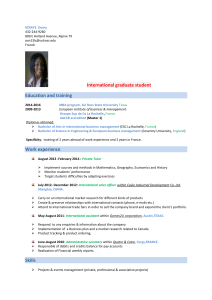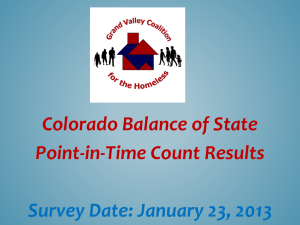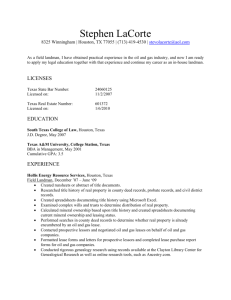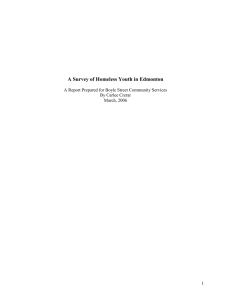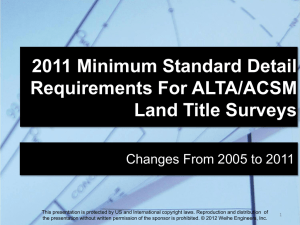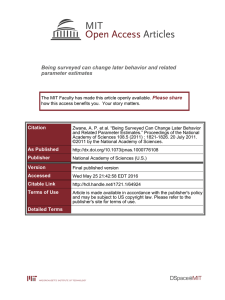Pay Inequalities of Women and Men:
advertisement
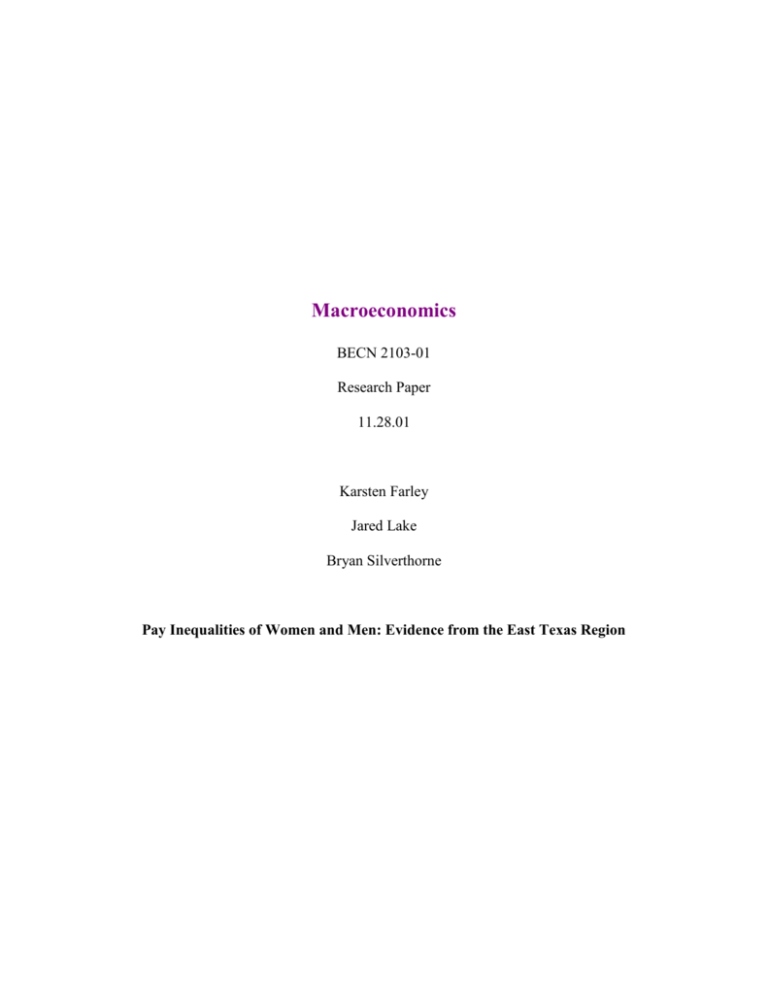
Macroeconomics BECN 2103-01 Research Paper 11.28.01 Karsten Farley Jared Lake Bryan Silverthorne Pay Inequalities of Women and Men: Evidence from the East Texas Region Abstract The purpose of the paper is to report the differences in pay between men and women of the East Texas Region. Data is to be collected from a varied range of businesses and industries of different professions. Several aspects will be taken into account for each of the cases. Factors such as age, race, married or single, children or no children, work experience, and level of education attained, will be recorded. Introduction This paper studies the difference of pay for Men and Women in the East Texas Region. Longview, TX was the central location for administering surveys in order to collect useful data. Men and Women from several different types of professions, backgrounds, and levels of education and experience, were surveyed. These were determined to be the most relevant factors in employee pay ranges. The purpose of the collected data was to find any gap in the pay between genders. Questions were asked to a broad cross section of the population in order that the data collected would cover all different types of working environments. This is a difficult topic to cover completely as all information is subject to the discretion of the people surveyed. However, the data as a whole represents a reliable collection of incomes. Literature review The following is a list of references used during initial planning of the research. They were used to help create a format for gathering data. These sources lent clues on different methods used to gather, compile, and analyze all data. AMERICAN ASSOCIATION OF UNIVERSITY PROFESSORS. Summary of Recent Studies on Wage Gap Between Men and Women Professors. 13 July 2000 <http://www.aaup.org/wstudy.htm> This analysis use data from the National Survey of Postsecondary Faculty (1993), conducted by NCES. The subsamples used for the analyses differ somewhat, as do the regression models (variables included, as well as their construction). The regression controls for race, years since highest degree (in ten-year categories), holding a doctorate or professional degree (versus another degree), level of instruction (undergraduate, graduate, or both), ratio of percent time spent in teaching to time spent in research, number of publications in the two years prior to the survey, institutional type, region of the country where institution is located. Swaffield , Joanna. “Women’s pay Is discrimination still an issue? <http://www.centrepiece-magazine.com/spring00/womens_pay.htm> They used the British Household Panel Survey (BHPS), which usefully includes detailed lifetime labor market histories of workers. This enables them to make direct comparisons of the alternative measures of labor market experience – actual and potential. Potential labor market experience is the amount of time someone could have spent at work. A fifty- year old who left school at fifteen, for instance, can be said to have potential work experience of 35 years. Of course, this is only a rough approximation for someone’s actual experience: one obvious drawback is that the fewer absences someone has from the labor market, the more accurate will be this proxy measure. Joshi, Heather. “Pay Differences Between Men and Women: Longitudinal Evidence from the 1946 Birth Cohort”. Mar. 1987 <http://ideas.uqam.ca/ideas/data/Papers/cprceprdp156.html> The MRC National Survey of Health and Development provides data on the hourly pay of males and females. The data has been subjected to regression analysis to see how far the gap between men's and women's pay is statistically explicable by: (a) a `human capital' model covering measures of ability, educational attainment and work experience, and (b) a model which also includes characteristics of the sector of employment. “Pay Equity: differences between women and men farm workers “. <http://www.case.org.za/htm/payeq2.htm> Data collection comprised of in-depth interviews with farm managers or owners, and separate focus groups with women and men farm workers. All discussions and interviews were tape recorded and then transcribed so that in-depth analysis could be done. The indepth interview was designed to access key information regarding the work done on the farm, basic conditions of work, wage structure and determinants, as well as determining any significant differences between conditions for men and women workers. Focus groups are semi-structured discussions with selected groups to explore how participants feel about particular issues and topics. Focus groups were used to collect qualitative data on how workers viewed conditions on farms and touched on key issues such remuneration, benefits and work functions. Data Collection and Analysis The goal of the data collection was to create a series of questions having characteristics relevant to the topic. It was determined that questions seeking personal information would yield the most useful and accurate data. Although the most important facts to be collected were gender and annual income, it was necessary to discover more about each individual. Personal attributes such as motivation, age, willingness to work, and family life play important roles in ones ability to perform on the job. As a result, the same criteria will affect a persons career choices as well as level of income. This broadens the scope of the input, increasing the detail of the recorded information. In order that the data analysis is accurate as possible, a complete picture of the subjects interviewed must be recorded. Below is a copy of the questions asked during the interview process. No names were taken to avoid any uncomfortable feelings a person might have as a result of some of the questions. Survey Questions: 1. Male or female? 2. Age? 3. What is your profession? 4. What are your job responsibilities? 5. Do you enjoy your job? 6. What is your level of education? 7. What is your level of experience? 8. Does your company offer incentives for promotion? 9. Does this want to make you work harder? 10. Please state your income to the nearest $10,000. 11. Please state your marital status? Single Married Divorced Widow/Widower The question of income is the most delicate question asked in this survey. Most people responded without hesitation, but there were a few uncomfortable replies. It is crucial to create a friendly atmosphere while interviewing so that a more truthful answer is given. This goes for all the questions. Some responses to the income question were given to nearest $5,000. Methodology Data collection methods consisted of person-to-person surveys administered over the telephone and at various employment locations. The nature of the questions asked creates a greater need for a face-to-face conversation. People interviewed were told that the questions asked were for a general survey of the working population. The specific nature of the survey was not given. Again, this increased the accuracy of the data, as well as avoided any biased answers. After the collection, an evaluation of the data led to the elimination of question four of the survey. It was covered by the other questions. All data was entered into tables in Excel. This allowed for the arrangement and analysis of the data. Each question is listed by number in a column with the corresponding value down the column. The rows represent the number of people interviewed at the specified location or by telephone. After further evaluation of the data, it was determined that the most relevant questions were those of age, experience, income, and gender. These were used as the basis for the graphs. Three graphs show values for both women and men under the categories of age, experience, and income. A comparison of the data can be made using the visual representation provided by the graphs. Results The age groups for the women are between 18 at the youngest and 46 at the oldest. The average age for them is 26. The age group for the men is between 18 years old and 45 years old. The average age for the men is 23. The income of women is between $10,000 and $85,000. The average is approximately $27,000. Two women in we surveyed were making an above average income of $75,000 and $85,000. The income for the men of east Texas is between $10,000 and $80,000. The average of the men’s income was $25,000. Of the men and women surveyed the men had a bigger income on the average but of all the surveyors a woman had the highest income at $85,000. The ladies years of experience in their fields ranged between 1 year and 20 years and the average experience the ladies of east Texas had is around 7 years. By comparing the years of experience and the income graph it is clearly evident that they have a direct relationship. The more years of experience that the ladies had directly affected the amount of income they received. The years of experience that the men of East Texas have range from 1 year to 21 years. The average years of experience that the men had was 5 and a half years. By comparing the years of experience and the income graph it is clearly evident that they have a direct relationship. The more years of experience that the men had directly affected the amount of income they received. Conclusions This paper studies the differences in pay between Men and Women in the East Texas Region. The Survey Data shows that unequal pay for men and women virtually does not exist. For employees who have like skill and experience, pay is relatively the same. There seems to be no discrepancy on the amount paid to individuals, regardless of their gender. Age 60 Age (years) 50 40 30 20 10 0 1 3 5 7 9 11 13 15 17 19 21 23 25 27 29 31 33 35 Num ber Surveyed men w omen Experience Experience (years) 25 20 15 10 5 0 1 3 5 7 9 11 13 15 17 19 21 23 25 27 29 31 33 35 Num er Surveyed men w omen Annual Income ($) Income $100,000 $80,000 $60,000 $40,000 $20,000 $0 1 3 5 7 9 11 13 15 17 19 21 23 25 27 29 31 33 35 Num ber Surveyed men w omen






